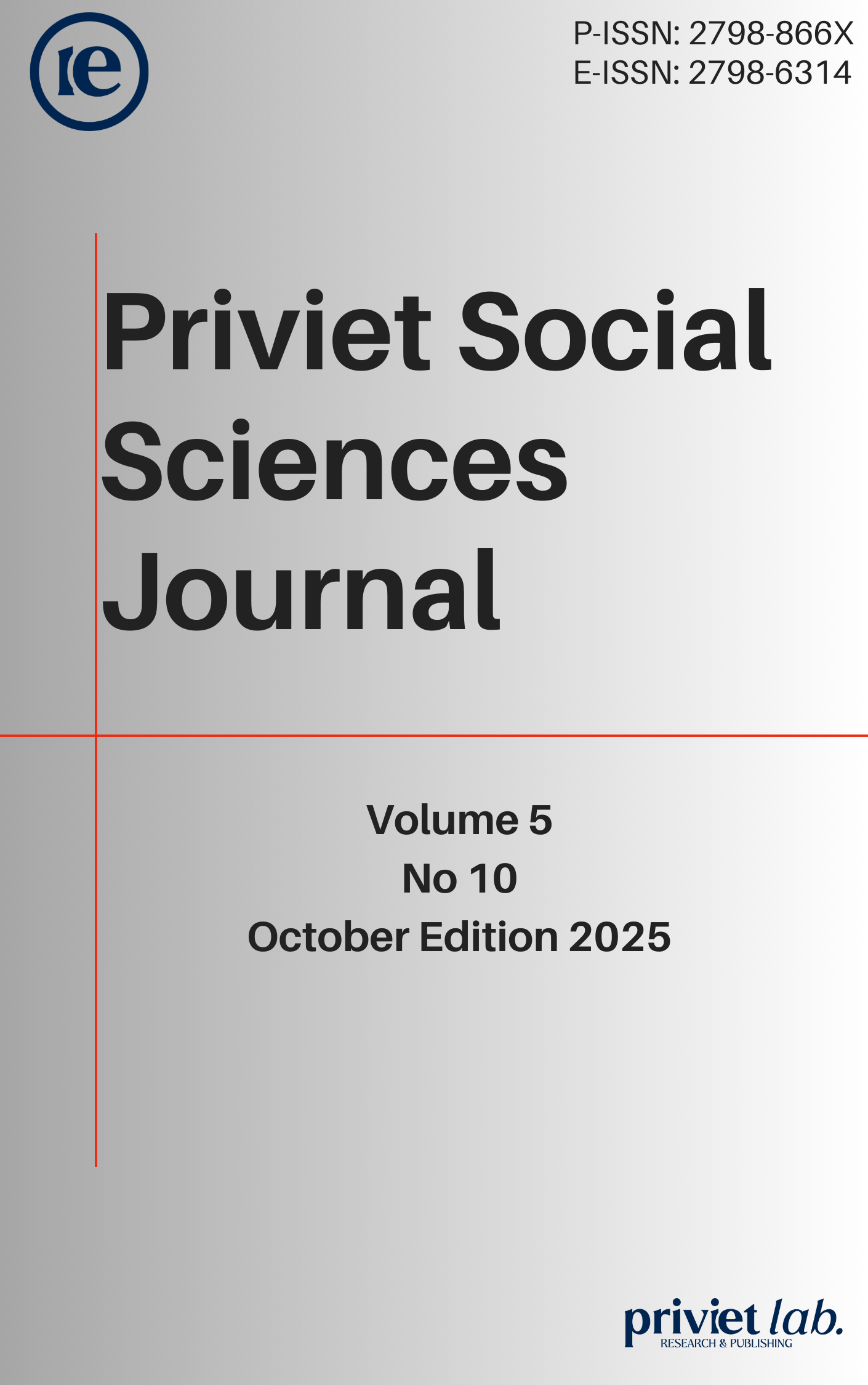Comparison of capital structure, risk, and profitability between Islamic and conventional banks in Indonesia
DOI:
https://doi.org/10.55942/pssj.v5i10.588Keywords:
capital structure, conventional banks, equity proportion, islamic banks, profitability, riskAbstract
This study aims to compare Islamic and Conventional Banks in Indonesia in terms of Capital Structure, Profitability, and Risk handling. Data for the analysis were taken from the quarterly financial reports of nine Islamic and Conventional Banks for the 2013Q1 – 2020Q3 period. Binary logistic regression was employed as an analysis tool using SPSS 19 software. The results show that Islamic and Conventional Banks are significantly different in terms of capital structure, profitability, and risk handling. Conventional banks have better capital structures and profitability. Islamic Banks, on the other hand, have better risk management.
References
Abedifar, P., Molyneux, P., & Tarazi, A. (2013). Risk in Islamic banking. Review of Finance, 17(6), 2035–2096. https://doi.org/10.1093/rof/rfs041 DOI: https://doi.org/10.1093/rof/rfs041
Abdelsalam, O., Dimitropoulos, P., Elnahass, M., & Leventis, S. (2016). Earnings management behaviors under different monitoring mechanisms: The case of Islamic and conventional banks. Journal of Economic Behavior and Organization, 132, 155–173. https://doi.org/10.1016/j.jebo.2016.04.022 DOI: https://doi.org/10.1016/j.jebo.2016.04.022
Agoraki, M. E. K., Delis, M. D., & Pasiouras, F. (2011). Regulations, competition and bank risk-taking in transition countries. Journal of Financial Stability, 7(1), 38–48. https://doi.org/10.1016/j.jfs.2009.08.002 DOI: https://doi.org/10.1016/j.jfs.2009.08.002
Al-Hunnayan, S. H. (2020). The capital structure decisions of Islamic banks in the GCC. Journal of Islamic Accounting and Business Research, 11(3), 745–764. https://doi.org/10.1108/JIABR-02-2017-0026 DOI: https://doi.org/10.1108/JIABR-02-2017-0026
Apriliani, L., & Ibnu, A. R. (2018). Analisis struktur modal Bank Syariah Mandiri terhadap tingkat profitability periode 2013–2018. Jurnal Nisbah, 5(2), 116–126. https://ojs.unida.ac.id/JN/article/view/1836
Asutay, M., Ayturk, Y., & Aksak, E. (2020). The effects of regulation and supervision on the risk-taking behaviour of Islamic banks. Journal of Islamic Accounting and Business Research. https://doi.org/10.1108/JIABR-12-2019-0222 DOI: https://doi.org/10.1108/JIABR-12-2019-0222
Athanasoglou, P., Brissimis, S., & Delis, M. (2008). Bank-specific, industry-specific and macroeconomic determinants of banks’ profitability. International Financial Markets, Institutions and Money, 18(2), 121–136. https://doi.org/10.1016/j.intfin.2006.07.001 DOI: https://doi.org/10.1016/j.intfin.2006.07.001
Beck, T., Demirgüç-Kunt, A., & Merrouche, O. (2013). Islamic vs. conventional banking: Business model, efficiency and stability. Journal of Banking and Finance, 37(2), 433–447. https://doi.org/10.1016/j.jbankfin.2012.09.016 DOI: https://doi.org/10.1016/j.jbankfin.2012.09.016
Bitar, M., & Madiès, P. (2017). What makes Islamic banks different? A multivariate approach. Economic Systems, 41(2), 215–235. https://doi.org/10.1016/j.ecosys.2016.06.003 DOI: https://doi.org/10.1016/j.ecosys.2016.06.003
Black, F., & Scholes, M. (1973). The pricing of options and corporate liabilities. Journal of Political Economy, 81(3), 637–654. https://doi.org/10.1086/260062 DOI: https://doi.org/10.1086/260062
Brigham, E. F., & Houston, J. F. (2019). Fundamentals of financial management. Cengage Learning.
Bukair, A. A. A. (2019). Factors influencing Islamic banks’ capital structure in developing economies. Journal of Islamic Accounting and Business Research, 10(1), 2–20. https://doi.org/10.1108/JIABR-02-2014-0008 DOI: https://doi.org/10.1108/JIABR-02-2014-0008
Chatti, M. A. (2012). L’impact de l’éthique bancaire sur la diversification d’une banque islamique. Etudes En Economie Islamique, 6(1/2), 1–27. DOI: https://doi.org/10.12816/0034689
Dietrich, A., & Wanzenried, G. (2011). Determinants of bank profitability before and during the crisis: Evidence from Switzerland. Journal of International Financial Markets, Institutions and Money, 21(3), 307–327. https://doi.org/10.1016/j.intfin.2010.11.002 DOI: https://doi.org/10.1016/j.intfin.2010.11.002
Hutauruk, F. N. (2020). Ukuran perusahaan sebagai pemoderasi dalam hubungan profitabilitas dan likuiditas terhadap struktur modal bank umum syariah. EKONOMIKA SYARIAH: Journal of Economic Studies, 4(2), 136. https://doi.org/10.30983/es.v4i2.3633 DOI: https://doi.org/10.30983/es.v4i2.3633
Jensen, M., & Meckling, W. (1976). Theory of the firm: Managerial behavior, agency costs, and ownership structure. Journal of Financial Economics, 3, 305–360. https://doi.org/10.1016/0304-405X(76)90026-X DOI: https://doi.org/10.1016/0304-405X(76)90026-X
Klomp, J., & Haan, J. D. (2012). Banking risk and regulation: Does one size fit all? Journal of Banking and Finance, 36(12), 3197–3212. https://doi.org/10.1016/j.jbankfin.2011.10.006 DOI: https://doi.org/10.1016/j.jbankfin.2011.10.006
Konishi, M., & Yasuda, Y. (2004). Factors affecting bank risk taking: Evidence from Japan. Journal of Banking and Finance, 28(1), 215–232. https://doi.org/10.1016/S0378-4266(02)00405-3 DOI: https://doi.org/10.1016/S0378-4266(02)00405-3
Lintner, J. (1965). The valuation of risk assets and the selection of risky investments in stock portfolio and capital budgets. The Review of Economics and Statistics, 47(1), 13–37. https://doi.org/10.2307/1924119 DOI: https://doi.org/10.2307/1924119
Mardhatillah, B. A., Waluyo, B., & Fatah, D. A. (2020). Pengaruh corporate social responsibility (CSR) dan struktur modal terhadap profitabilitas bank umum syariah di Indonesia. SERAMBI: Jurnal Ekonomi Manajemen Dan Bisnis Islam, 2(3), 177–186. https://doi.org/10.36407/serambi.v2i3.238 DOI: https://doi.org/10.36407/serambi.v2i3.238
Markowitz, H. (1952). Portfolio selection. The Journal of Finance, 7(1), 77–91. https://doi.org/10.1111/j.1540-6261.1952.tb01525.x DOI: https://doi.org/10.1111/j.1540-6261.1952.tb01525.x
Metwally, M. M. (1997). Differences between the financial characteristics of interest-free banks and conventional banks. European Business Review, 97(2), 92–98. DOI: https://doi.org/10.1108/09555349710162607
Mokni, R. B. S., & Rachdi, H. (2014). Assessing the bank profitability in the MENA region: A comparative analysis between conventional and Islamic bank. International Journal of Islamic and Middle Eastern Finance and Management, 7(3), 305–332. https://doi.org/10.1108/IMEFM-03-2013-0031 DOI: https://doi.org/10.1108/IMEFM-03-2013-0031
Mollah, S., & Zaman, M. (2015). Shari’ah supervision, corporate governance and performance: Conventional vs. Islamic banks. Journal of Banking and Finance, 58, 418–435. https://doi.org/10.1016/j.jbankfin.2015.04.030 DOI: https://doi.org/10.1016/j.jbankfin.2015.04.030
Mollah, S., Hassan, M. K., Al Farooque, O., & Mobarek, A. (2016). The governance, risk-taking, and performance of Islamic banks. Journal of Financial Services Research, 1–25. https://doi.org/10.1007/s10693-016-0245-2 DOI: https://doi.org/10.1007/s10693-016-0245-2
Myers, S. C. (1977). Determinants of corporate borrowing. Journal of Financial Economics, 5(2), 147–175. https://doi.org/10.1016/0304-405X(77)90015-0 DOI: https://doi.org/10.1016/0304-405X(77)90015-0
Nasrah, H., & Resni, N. (2020). Faktor-faktor yang mempengaruhi struktur modal bank syariah di Indonesia tahun 2014–2018. Jurnal Tabarru’: Islamic Banking and Finance, 3(2), 281–294. https://doi.org/10.25299/jtb.2020.vol3(2).5881 DOI: https://doi.org/10.25299/jtb.2020.vol3(2).5881
Olson, D., & Zoubi, T. (2008). Using accounting ratios to distinguish between Islamic and conventional banks in GCC region. The International Journal of Accounting, 43(1), 45–65. https://doi.org/10.1016/j.intacc.2008.01.003 DOI: https://doi.org/10.1016/j.intacc.2008.01.003
Pohar, M., Blas, M., & Turk, S. (2004). Comparison of logistic regression and linear discriminant analysis: A simulation study. Metodološki Zvezki, 1(1), 143–161. DOI: https://doi.org/10.51936/ayrt6204
Sharpe, W. (1964). Capital asset prices: A theory of market equilibrium under conditions of risk. Journal of Finance, 19(3), 425–442. https://doi.org/10.1111/j.1540-6261.1964.tb02865.x DOI: https://doi.org/10.1111/j.1540-6261.1964.tb02865.x
Sheikh, N. A., & Qureshi, M. A. (2017). Determinants of capital structure of Islamic and conventional commercial banks: Evidence from Pakistan. International Journal of Islamic and Middle Eastern Finance and Management, 10(1), 24–41. https://doi.org/10.1108/IMEFM-10-2015-0119 DOI: https://doi.org/10.1108/IMEFM-10-2015-0119
Titman, S., & Wessels, R. (1988). The determinants of capital structure choice. The Journal of Finance, 43(1), 1–19. https://doi.org/10.1111/j.1540-6261.1988.tb02585.x DOI: https://doi.org/10.1111/j.1540-6261.1988.tb02585.x
Toumi, K., Louhichi, W., & Viviani, J.-L. (2012). Alternative financial decision principles: Theoretical foundations of Islamic banks’ capital structure. In Recent Developments in Alternative Finance: Empirical Assessments and Economic Implications, 22, 157–172. https://doi.org/10.1108/S1571-0386(2012)0000022013 DOI: https://doi.org/10.1108/S1571-0386(2012)0000022013
Wahyudi, R., Fithria, A., & Sartini, S. (2020). The relationship between capital structure and performance in Islamic rural bank. International Journal of Islamic Studies and Humanities, 3(2), 82–89. https://doi.org/10.26555/ijish.v3i2.1989 DOI: https://doi.org/10.26555/ijish.v3i2.1989
Yanikkaya, H., Gümüş, N., & Pabuçcu, Y. U. (2018). How profitability differs between conventional and Islamic banks: A dynamic panel data approach. Pacific-Basin Finance Journal, 48, 99–111. DOI: https://doi.org/10.1016/j.pacfin.2018.01.006
Downloads
Published
How to Cite
Issue
Section
License
Copyright (c) 2025 Ida Ayu Fatmayuni, Arowadi Lubis, Hikmah Endraswati

This work is licensed under a Creative Commons Attribution 4.0 International License.

















